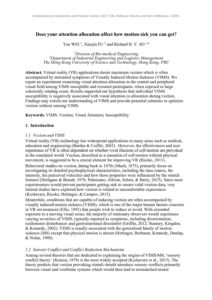| Document | Author Yue WEI, Xiaojin FU and Richard H. Y. SO |
| Abstract Virtual reality (VR) applications desire maximum vection which is often accompanied by unwanted symptoms of Visually Induced Motion Sickness (VIMS). We report an experiment examining visual attention allocation in the central and peripheral visual field among VIMS susceptible and resistant participants, when exposed to large coherently rotating scene. Results supported our hypothesis that individual VIMS susceptibility is negatively associated with visual attention re-allocation during vection. Findings may enrich our understanding of VIMS and provide potential solutions to optimize vection without causing VIMS. |

